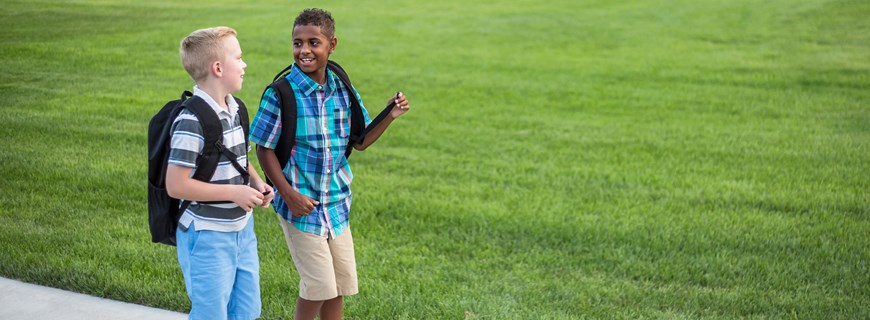Back to School Backpack Safety

Back to physical health resource hub
An ill-fitted backpack can affect a child’s physical health for years to come. Backpacks that are too heavy or worn incorrectly can cause disc compression, alter spinal curvature, weaken muscles and possibly cause nerve damage within the soft tissues of shoulders. Backpack strain may also cause poor posture which can affect endurance, digestive function, visual focus, motor coordination, and low self-esteem. Don’t mistake complaints of neck pain and/or shoulder soreness as “back to school” adjustments. It could be the bag they carry to school every day.
Here are a few easy steps to ensure that kiddos aren’t being “held back” by their backpacks:
- Be a backpack minimalist
- -Children should not wear a backpack that is more than 10% of their body weight (e.g. a child weighing 100 lbs. should carry a bag 10 lbs. or lighter).
- -Backpacks should carry only what the child needs for that day, so routinely go through and clean out unnecessary items
- Choose the backpack wisely
- Lightweight versus heavy (i.e. canvas vs. leather) material
- Thick-padded wide straps since thin ones can dig into shoulders
- Padded back to protect and increase comfort against your child’s back
- Waist belt and multiple compartments to help evenly distribute weight across the body and backpack
- Pack smarter not harder
- Think “back to back”, meaning the heaviest items should be placed closer to the back of the backpack and closest to the center of the child’s back
- Use compartments to help avoid slipping, as heavier items have a tendency to move towards the front if not restricted
- If necessary, a child can carry one item in their arms, such as a book or folder, to help decrease backpack weight
- Proper wearing is caring
- Wear both shoulder straps for appropriate weight distribution across the back
- If there is a waist belt, encourage your child to use it, especially when walking longer distances
- A backpack should not sit more than 4 inches below waistline and ideally should rest in the lower back curve
- Back up…don’t forget about body mechanics
- When picking up the backpack, make sure your child bends his or her knees then uses both hands while lifting it to the shoulders
- Encourage your child to use proper posture while wearing their backpack. Ensure their head is up, chin is back and ears are aligned over their shoulders (i.e. “stand tall like a giraffe”)
In addition to parental involvement, the key to success for proper backpack wearing is making both students and teachers active participants in backpack wear as well. It is important to educate your children on the importance of protecting their backs and also discussing ideas with teachers to keep backpack loads as light as possible.
To contact our Johns Creek Pediatric Outpatient clinic for more information, call: (904) 230-7761.
References:
- Backpack strategies for parents and students. (n.d.) Retrieved from https://www.aota.org/~/media/Corporate/Files/Backpack/Backpack%20Strategies%20for%20Parents%20%20Students.pdf
- Burns, Krista. (2018). Healthy backpack hacks all parents should know. Retrieved from https://americanpostureinstitute.com/healthy-backpack-hacks-all-parents-should-know/
- Burns, Krista. (2017). Tall posture, high self-esteem. Retrieved from https://americanpostureinstitute.com/tall-posture-high-self-esteem/
- Dowshen MD, Steven. (2016). Backpack safety. Retrieved from https://kidshealth.org/en/parents/backpack.html
- Han, J. et al. (2016). Effects of forward head posture on forced vital capacity and respiratory muscles activity. Journal of Physical Therapy Science, 28(1) p.128-131
- Manning-Schaffel, Vivian. (2017). Why our bags are wrecking our backs. https://www.nbcnews.com/better/health/why-bags-are-wrecking-our-backs-ncna803541


